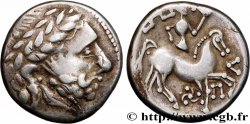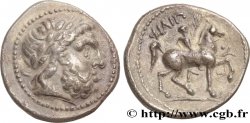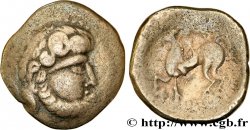bga_477560 - DANUBIAN CELTS - IMITATIONS OF THE TETRADRACHMS OF PHILIP II AND HIS SUCCESSORS Tétradrachme au type “Bartkranzaverse”
Not available.
Item sold on our e-shop (2018)
Price : 2 250.00 €
Item sold on our e-shop (2018)
Price : 2 250.00 €
Type : Tétradrachme au type “Bartkranzaverse”
Date: c. IIe-Ier siècles AC.
Metal : silver
Diameter : 25 mm
Orientation dies : 12 h.
Weight : 13,83 g.
Rarity : R3
Coments on the condition:
Exemplaire sur un flan large et régulier avec une frappe vigoureuse et de beaux reliefs. Fine patine grise avec de légers défauts de surface
Catalogue references :
Obverse
Obverse legend : ANÉPIGRAPHE.
Obverse description : Tête barbare barbue à droite, une sorte de couronne de lauriers tombe sur l'arrière de la chevelure ; grènetis circulaire.
Reverse
Reverse legend : ANÉPIGRAPHE.
Reverse description : Cavalier casqué au pas à gauche ; une sorte de rameau devant le visage, un petit animal devant le poitrail et trois annelets pointés entre les jambes du cheval ; le casque se termine par un annelet.
Commentary
Ce type est directement inspiré par le “type au rameau” ; à l’extrémité du “casque chevelure” se trouve un annelet. Devant, entre le cheval et le cavalier, nous trouvons un rameau qui rappelle la palme du héros du tétradrachme de Philippe II de Macédoine (GC 6680). Sous la bouche du cheval, un petit quadrupède ne peut être rapproché d’aucun symbole connu des ateliers de Pella ou d’Amphipolis.








 Report a mistake
Report a mistake Print the page
Print the page Share my selection
Share my selection Ask a question
Ask a question Consign / sell
Consign / sell
 Full data
Full data



